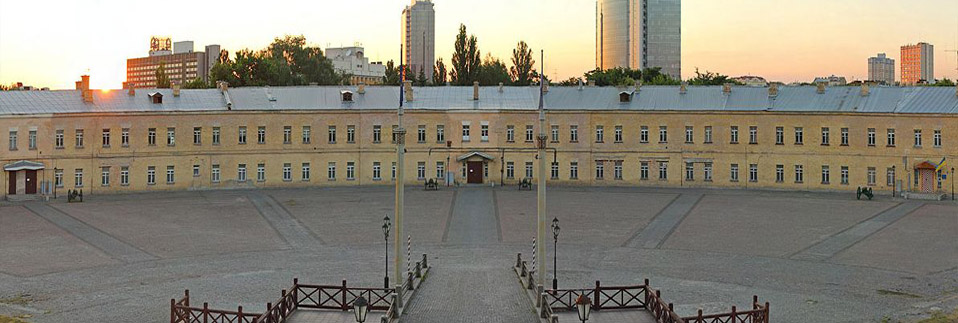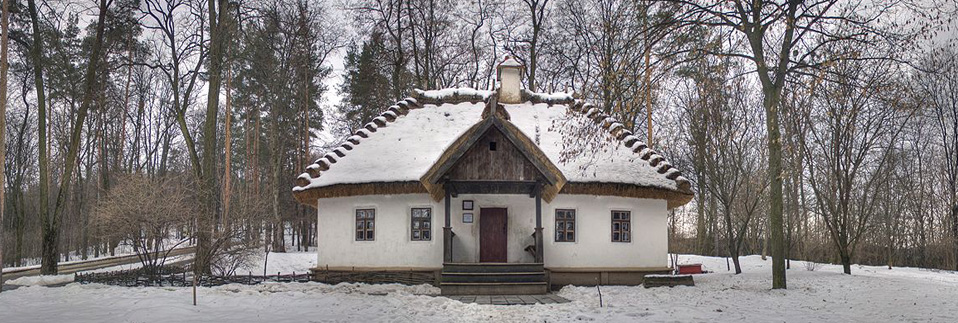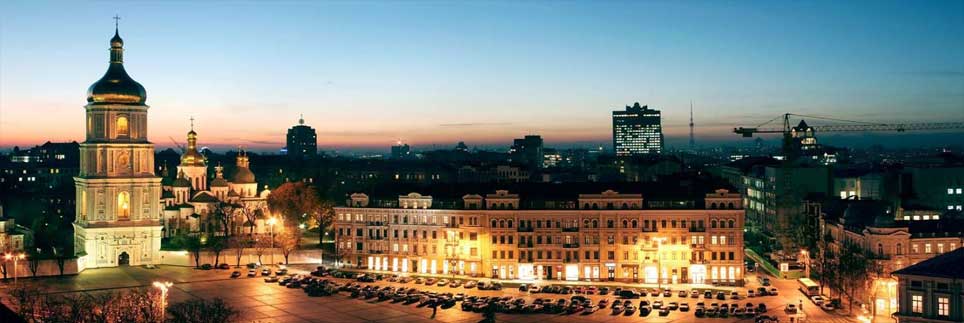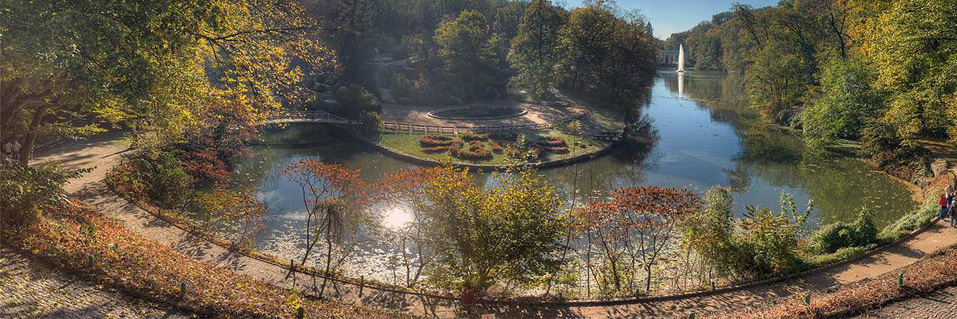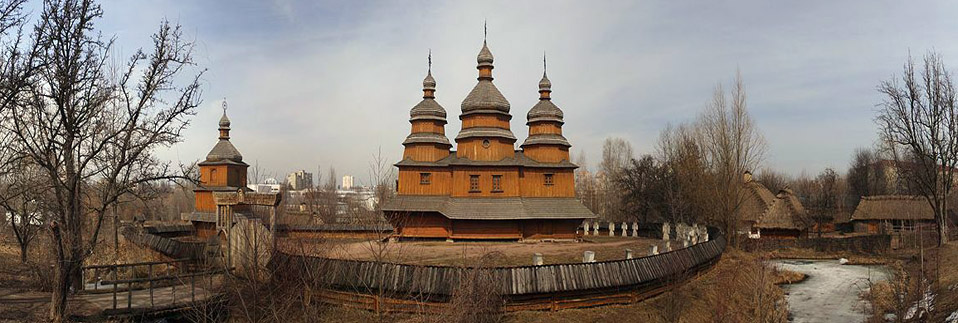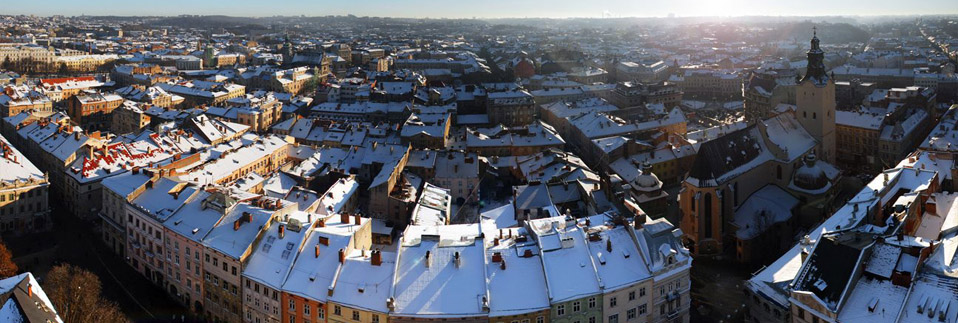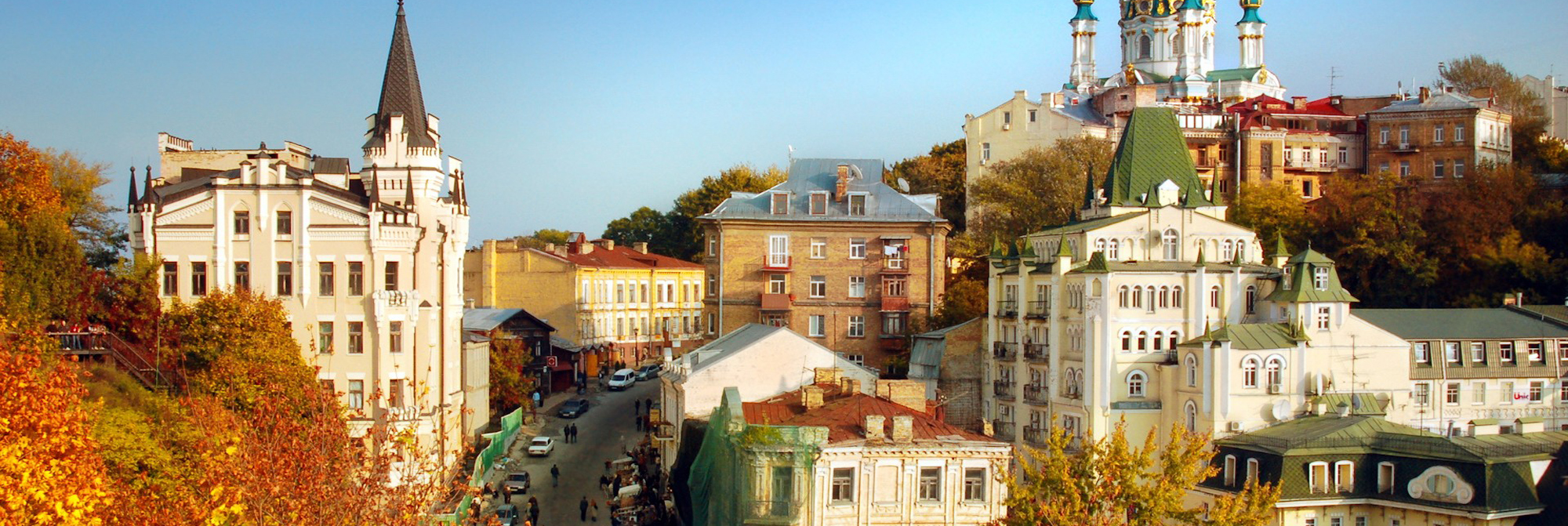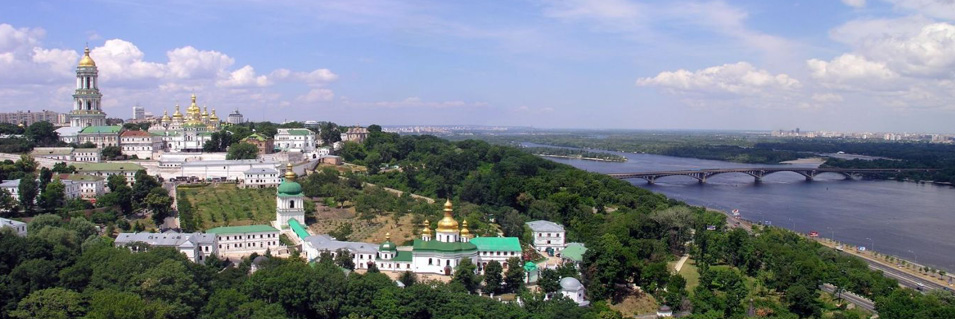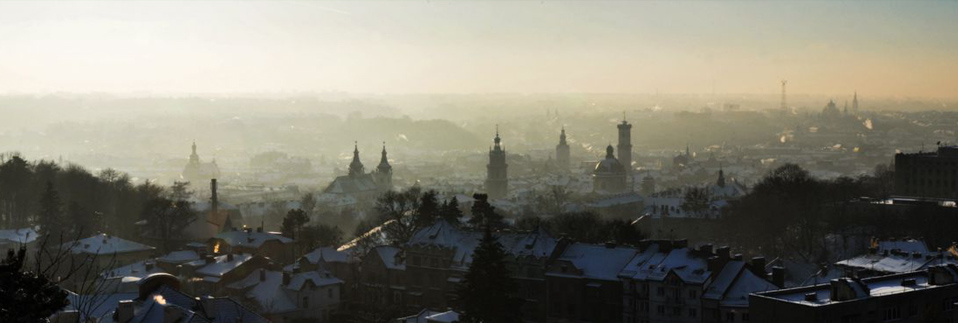Kiev
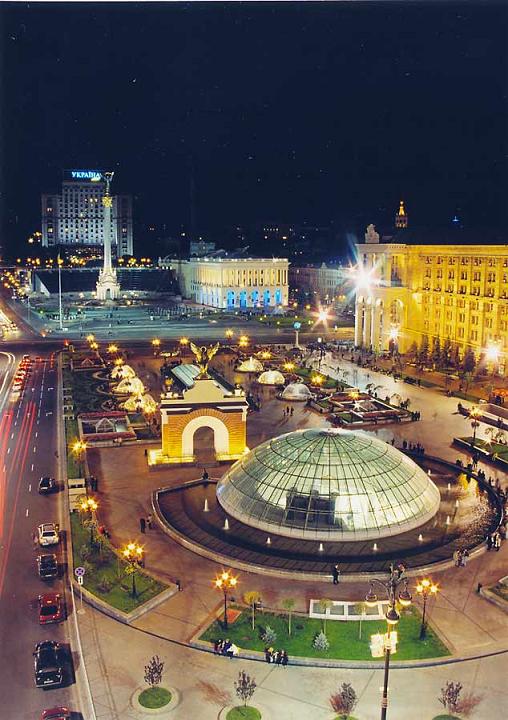 Guided panoramic city tour of Kiev includes the main sights and the traditional tourist favourits ("in view only")
Guided panoramic city tour of Kiev includes the main sights and the traditional tourist favourits ("in view only")
- Starokyivska Hill where Kiev's first fortress was built and now one can see the remnants of the foundations of its first constructions.
- Adriyivskyi descent - a thousand years old street connecting in the days of Kiev Rus-Ukraine the Upper part of Kiev with the Lower one. Today the Descent is under the renovation and is stylised in the 19th century spirit. Now it is the Montmartre of Kiev filled with the art shops and exhibits, cafes. The street is full of beauty and charm. This is a traditional place for concerts, festivals, art exhibits, Days of Kiev Festivals.
- Andriyivska (St.Andrew) church - the real pearl of Ukrainian and Russian architecture, was built in 1754 by B.Rastrelli in baroque style, it sprang up on the place where Apostle Andrew overshadowed for the first time this land with the Holy Cross, and it was the place where Christianity began to spread among the Eastern Slavs. The church is under restoration and yet not open to public.
- The Golden Gate (erected in 1036, reconstructed in 1982).
- Some monuments - the monument to Prince Volodymyr, who introduced Christianity in Kievan Rus in 988, the monument to Taras Shevchenko, St.Volodymyr Cathedral - of great artistic value built in 1882 in neo-Byzantine style. Famous painters Vasnetsov, Nesterov, Vrubel and Pimonenko worked here. It is a genuine pleasure to hear the psalms sung by the St.Volodymyr Cathedral Choir. This is the Seat of the Patriarch of the Ukrainian Orthodox Church of the Kiev Patriarchate (services are daily at 9 AM and 6 PM).
- The Mariinsky Palace (former Tsar's Palace, built in XVIII c. by Bartolomeo Rastrelli, at present the palace is used for presidential official functions).
- Main street of the city Khreschatyk , everybody who visits Kiev for sure walks along this thoroughfare, admiring its architecture, fountains, greenery and blossoms of the famous Kiev chestnut trees. The road was one of Kiev's very first and once followed a clear stream flowing into the Dnepr. During World War II, the Soviets sabotaged most of the street so that it would blow up after the Nazis had entered the city. Everything you see today has been rebuilt; people may criticise the pomp of post-war Stalinist architecture, but these monumental structures define Kiev today. The central focal point of the boulevard is the Maidan Nezalezhnosti (Independence Square). November-December 2004 it was the Place of the Orange Revolution that was shown to whole world on TV. Big underground mall with exquisite shops is one of the largest shopping center in the city. Near the central post office, lots of friendly Ukrainians are selling flags, books, and music and badges. On the opposite side of the street is Kiev's newest monument, a white and gold pillar erected in 2001 to celebrate a decade of independence. Down below, on the left side is another recent bronze sculpture showing the founders of Kiev.
- Where Khreschatyk begins its descent to the river stands a giant arch over the brawny statues of two 'brothers' - Ukraine and Russia, erected in the Soviet period, here is the one of the most wonderful views of the river and the city. The park continues south all the way to the Caves Monastery, museum of history WW2, and botanical gardens.
- Not far from this place steppy street leads to the political center of the country - buildings of Ukrainian Parliament (Supreme Rada), of Ukrainian Government, of National Bank..
St.Sophia Cathedral
 The foundation of this multidomed, five-naved church was laid by Prince Yaroslav the Wise in honour of his victory over the Pechenegs in 1037 and it was erected by unknown local masters. As ancient Rus it was the main metropolitan church and was symbolising the wisdom of Christianity. At the same time the Cathedral was the centre of the state social and cultural life. It witnessed the ceremony of the princes' "seating" on the throne, the debating of the Kiev "veche" (people's assembly), reception of the West European sovereigns, dynastic rituals, the foundation of the first Russian library. As you cross the Cathedral's threshold, you are immediately seized by its grandeur and splendour. Its majestic size (length-27 m, width-55 m, height-29 m), austere inner proportions and monumental wall decorations (260 sq. of mosaics and about 3,000 sq. m of frescoes) dating from the 11th c. overwhelm the visitor with their perfection. The marble sarcophagus of Prince Yaroslav the Wise, the wooden carved iconostasis dating from the 18th c. have also survived. Saint Sophia is not only a national treasure of Ukraine - it belongs to all Christian world and is under the protection of UNESCO.
The foundation of this multidomed, five-naved church was laid by Prince Yaroslav the Wise in honour of his victory over the Pechenegs in 1037 and it was erected by unknown local masters. As ancient Rus it was the main metropolitan church and was symbolising the wisdom of Christianity. At the same time the Cathedral was the centre of the state social and cultural life. It witnessed the ceremony of the princes' "seating" on the throne, the debating of the Kiev "veche" (people's assembly), reception of the West European sovereigns, dynastic rituals, the foundation of the first Russian library. As you cross the Cathedral's threshold, you are immediately seized by its grandeur and splendour. Its majestic size (length-27 m, width-55 m, height-29 m), austere inner proportions and monumental wall decorations (260 sq. of mosaics and about 3,000 sq. m of frescoes) dating from the 11th c. overwhelm the visitor with their perfection. The marble sarcophagus of Prince Yaroslav the Wise, the wooden carved iconostasis dating from the 18th c. have also survived. Saint Sophia is not only a national treasure of Ukraine - it belongs to all Christian world and is under the protection of UNESCO.
Address: 24, Volodymyrska St
Kiev-Pechersk Lavra (Cave Monastery)
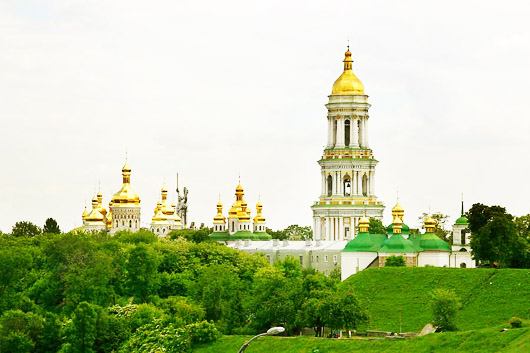 A "must see" visit in Kiev. Founded in 1051 by the monks Antonyi and Feodosyi. In the 11th c. it became the centre for the expansion and consolidation of Christianity in Kyivan Rus. In the late 16th c. it was designated a title of Lavra. "Lavra" is the term used by the Orthodox Church for the largest autonomous monasteries. Pechersk Lavra was one of the most famous monasteries in historical Kyiv Rus State and the former Russian Empire.
A "must see" visit in Kiev. Founded in 1051 by the monks Antonyi and Feodosyi. In the 11th c. it became the centre for the expansion and consolidation of Christianity in Kyivan Rus. In the late 16th c. it was designated a title of Lavra. "Lavra" is the term used by the Orthodox Church for the largest autonomous monasteries. Pechersk Lavra was one of the most famous monasteries in historical Kyiv Rus State and the former Russian Empire.
Being a site of pilgrimage for the Orthodox Christians throughout Europe, for centuries it was an Orthodox Christianity's "Rome". A "cave" is "pechera" in Ukrainian, hence the name of the monastery. Monks prayed and lived in the caves which can be visited. The monks were also buried in these caves. The combination of the cool temperature and soil composition of the caves allowed the bodies of the dead to mummify. At the time of the monastery's foundation this appeared to be a miracle enhancing the monastery's prestige. Even today the bodies remain almost perfectly preserved.
In 12th c. Lavra became a leading religious and cultural centre of Eastern Europe. Lavra had icon-painting studios and a scriptorium where works of ancient and contemporary foreign writers were translated into Slavic. The architectural ensemble attained completion in the mid-18th century. The majority of the structures where built in the Ukrainian Baroque style. This functioning monastery consists of numerous churches, towers, and caves with ancient crypts and ecclesiastical objects. The ensemble is in full harmony with the relief and forms a beautiful silhouette of Kyiv from the Dnipro River side. In 1926 the Historical-Cultural Preserve was established on the grounds of the monastery. In 1990 the site was included on UNESCO's World Heritage List.
Address: 21, Sichnevoho Povstania
 The Museum of Historical Treasures possesses one of the richest systematised collection of the jewellery manufacturing history during about three millennia. The collection includes the chefs d'oeuvre of the world value, such as a Scythian pectoral from the Tovsta Mohyla kurhan (grave-hill) dating from the 4th century B.C., a silver vase from the Haimanova Mohyla, dating from the second half of the 4th century B.C. It reveals the aesthetic ideals and mentality of the tribes and peoples who lived in this land.
The Museum of Historical Treasures possesses one of the richest systematised collection of the jewellery manufacturing history during about three millennia. The collection includes the chefs d'oeuvre of the world value, such as a Scythian pectoral from the Tovsta Mohyla kurhan (grave-hill) dating from the 4th century B.C., a silver vase from the Haimanova Mohyla, dating from the second half of the 4th century B.C. It reveals the aesthetic ideals and mentality of the tribes and peoples who lived in this land.
The collections of the 16th-20th centuries Ukrainian jewellery are most interesting. One of the most fascinating possessions of the Museum is a collection of the Judaic ritual silver objects (18th-20th centuries). A separate department represents the contemporary jewellery.
Address: 21, Sichnevoho Povstannia (the territory of the National Historical and Cultural Kyiv-PecherskLavraMuseum).
 The collection of the Museum totals more than 73,000 works of art. These are fabrics, tapestries, embroideries, pottery, woodcarvings, ivory, leather and metal items, folk paintings, decorative glass, porcelain and glazed pottery.
The collection of the Museum totals more than 73,000 works of art. These are fabrics, tapestries, embroideries, pottery, woodcarvings, ivory, leather and metal items, folk paintings, decorative glass, porcelain and glazed pottery.
Address: 21, Sichnevoho Povstannia (Kyiv-Pechersk Lavra, former Metropolitan Residence).
It is an architectural monument of the 12th c. It was used as a family burial site for Princess Olga's descendants. The visitors can see the tomb of Prince Svyatoslav Vsevolodovych, one of the characters of the ancient Slavic literary masterpiece "The Sayings of Prince Igor". The walls were covered with frescoes out of which 800 sq. m have survived. In the 17th and 18th cc. the church was rebuilt in the Ukrainian Baroque style. The paintings by famous Russian painter M.Vrubel and other unique objects have also been preserved. Mainly it operates as a museum. Services are held on major religious holidays.
Address: 12, Oleny Telihy St.
 The Museum is located in the house built in mid-1880s by the famous sugar producer and patron of arts F.Tereshchenko. The collection amounts to 12,000 pieces of paintings, graphics, sculpture, applied arts dating from the times of Kiev Rus to the present day.
The Museum is located in the house built in mid-1880s by the famous sugar producer and patron of arts F.Tereshchenko. The collection amounts to 12,000 pieces of paintings, graphics, sculpture, applied arts dating from the times of Kiev Rus to the present day.
The Museum is famous for its considerable collection of works by D.Levitsky, V.Borovykovsky, V.Tropinin, O.Kiprensky, I.Aivazovsky, L.Perov, M.Ghe, V.Vereshchagin, I.Repin, I.Kramskoi, M.Vrubel, M.Nesterov, E.Lanceret, M.Antokolsky, V.Polenov, I,Shishkin, O.Deineka, V.Mukhina, S.Konenkov, Yu.Pimenov. Such world-known masterpieces as the icon "Saints Borys and Hlib" (12th c.); "Players" by P.Fedotov; "The Merchant Women" (1912) by B.Kustodiev; "Nicholas" (1914) by M.Rurich etc. are in view.
Address: 9, Tereshchenkivska St
 The museum was founded in 1899 on the initiative of the Association of Antiquities and Fine Arts. The building itself is an architectural monument of the late 19th century, it was constructed by famous Kiev architect V.Horodetsky. The present display occupies 18 rooms. The collection totals 20,000 works of art.
The museum was founded in 1899 on the initiative of the Association of Antiquities and Fine Arts. The building itself is an architectural monument of the late 19th century, it was constructed by famous Kiev architect V.Horodetsky. The present display occupies 18 rooms. The collection totals 20,000 works of art.
The most valuable exhibits of the Museum are:
- the icon "St.George with Scenes from His Life" (12th c.);
- the icon "Volynska Bohomatir" (Virgin of Volyn) (14th c.);
- icons of the Berezniansky iconostasis (18th c.);
- the realistic paintings by T.Shevchenko, M.Pimonenko, S.Vasylkivsky, O.Murashko, F.Krychevsky (the late 19th-early 20th centuries);
- the Ukrainian avant-garde paintings by K.Malevich, O.Ekster;
- the modern art paintings by V.Maksymovych, A.Manevych, I.Trush, O.Novakivsky, P.Kholodny;
- monumental paintings of M.Boichuk school;
-
the 20th century classical paintings by H.Svitlytsky, A.Petritsky, O.Shovkunenko, V.Kasian, A.Erdeli, J.Bokshai, V.Kostetsky, T.Yablonska, H.Yakutovych, etc.
Address: 6, Hrushevskoho Str.
The National Memorial Museum Of The Great Patriotic War 1941/45
 The museum was opened in 1981. The complex combines the Museum building with the monument to Motherland (62 m gigantic titanium female figure with a sword and shield in her hands in the style of Soviet "Socialist Realism" symbolising the Victory over the nazi Germany); a gallery of sculpture compositions commemorating the heroes of the battlefields and the rear front, the Glory Fire Cup; the alley of the hero cities and the exhibition of the arms from the World War II times. The major exposition is located in 14 rooms and includes more than 12,000 exhibits.
The museum was opened in 1981. The complex combines the Museum building with the monument to Motherland (62 m gigantic titanium female figure with a sword and shield in her hands in the style of Soviet "Socialist Realism" symbolising the Victory over the nazi Germany); a gallery of sculpture compositions commemorating the heroes of the battlefields and the rear front, the Glory Fire Cup; the alley of the hero cities and the exhibition of the arms from the World War II times. The major exposition is located in 14 rooms and includes more than 12,000 exhibits.
Address: 44, Sichnevoho Povstania St.
The Kiev History Museum
 The Museum was inaugurated on 26 May, 1982 in the former Klovsky palace, an architectural monument of the 18th century, to commemorate the 1500th anniversary of the foundation of the city.
The Museum was inaugurated on 26 May, 1982 in the former Klovsky palace, an architectural monument of the 18th century, to commemorate the 1500th anniversary of the foundation of the city.
The visitors of the Museum are fascinated with an exceptional archaeological collection of items found on the territory of the city; collection of icons, old books, ritual and cult objects, postcards, kyivans' household utensils; an interesting and comprehensive collection of photographic materials.
.
Address: 8, Pylypa Orlyka St.
The Ukrainian Museum Of Folk Architecture, Life And Traditions (Skansen - Out-Door Museum)
It was founded in 1969 as National culture reserve. The area covers 159 hectares of picturesque sites where more than 300 monuments of folk civil construction tradition are located, they are filled with household utensils, working instruments, clothes, works of folk art. The exposition is divided into sections representing historical and ethnographic regions of Ukraine. Every section features the churches, houses, household constructions and workshops of the 16th - early 20thc. They are furnished with instruments usually used for different manufacturing processes - weaving, cooper and potter making, fishing, etc.
Full day trip to Pereyaslav-Khmelnitsky. The State Historical And Architectural Reserve.
 This small Ukrainian town can be called a museum itself. More than twenty museums are open to the public including the museum of Folk Life and Architecture; the Hrygoryi Skovoroda (an Ukrainian poet and philosopher) Memorial Museum - he worked here as a professor of the local college in the mid -18thc.; the Sholom Aleichem (a Jewish writer) Museum. A remarkable collection of folk instruments is represented in the museum of the Kobzar ("bard") art. An interesting display represents the Museum of Bread. Other historical and cultural monuments of the complex: Mykhailivsky (St.Michael) Monastery (17th c.), Voznesensky (Ascension) Monastery (18th c.).
This small Ukrainian town can be called a museum itself. More than twenty museums are open to the public including the museum of Folk Life and Architecture; the Hrygoryi Skovoroda (an Ukrainian poet and philosopher) Memorial Museum - he worked here as a professor of the local college in the mid -18thc.; the Sholom Aleichem (a Jewish writer) Museum. A remarkable collection of folk instruments is represented in the museum of the Kobzar ("bard") art. An interesting display represents the Museum of Bread. Other historical and cultural monuments of the complex: Mykhailivsky (St.Michael) Monastery (17th c.), Voznesensky (Ascension) Monastery (18th c.).


